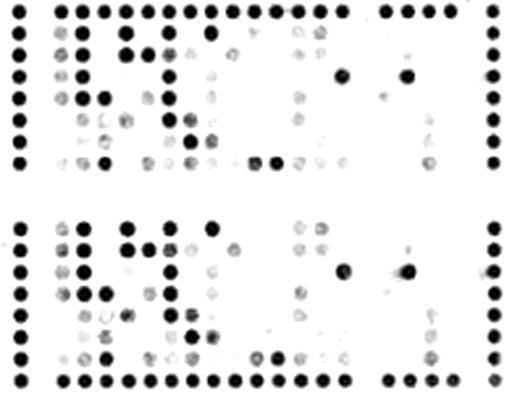Abstract
The recent development of a standardised proteomic microarray technique, DotScan, has allowed an innovative approach to the investigation of haematological disorders. In this study, mononuclear cells from 49 peripheral blood samples were studied to determine whether the technology could identify a differential consensus pattern of antigen expression for patients with monoclonal gammopathy of undetermined significance (MGUS) and multiple myeloma (MM). An automated reader simultaneously determined the expression of 82 different cell surface antigens by binding cells to antibodies on microscopic dots on the nitrocellulose-coated region of a microscope slide. The figure illustrates the image from a typical slide. A consensus pattern of antigen expression was analysed in duplicate by cross-validated discriminant analysis and a pilot database of disease groups was accumulated. Cross validated discriminant analysis successfully predicted patients with monoclonal gammopathy (98% success) and a discrete mosaic pattern could differentiate patients with MM who were treated with thalidomide (n=9). As expected, no single antigen could be used to discriminate between multiple myeloma (n=24), MGUS (n=14) and normal controls (n=11). Antigens with the highest ranking for differentiating the monoclonal gammopathies were CD25 (reduced after thalidomide), CD8 and CD57 (high in MM), CD28 (reduced in MM) and CD95 (reduced in MGUS) reinforcing the importance of immunomodulatory mechanisms in both MM and MGUS. Traditional flow cytometry was used to confirm these specific observations but also to demonstrate that the reduced CD28 expression was specific for CD8+ cells and the reduced CD95 expression was on CD8+ CD57+ cells. Three patients with MGUS were misclassified as MM but on review these 3 patients could have been classified as smoldering myeloma. There was no significant difference in the mosaic of 5 long term survivors of MM (> 10 years). This study has demonstrated the potential of using disease-specific databases to compare the mosaic of antigen expression for the diagnosis of monoclonal gammopathies. Long term studies will be required to accurately determine the prognostic significance at diagnosis and the ability of consensus patterns to identify which MGUS patients develop MM.
Figure
Specificity and sensitivity of proteomic array for monoclonal gammopathies
| . | MGUS . | MM . | MM Thal . | Normal . | Sensitivity % . | Specificity % . |
|---|---|---|---|---|---|---|
| MGUS prediction | 5 | 3 | 2 | 4 | 35 | 100 |
| MM prediction | 0 | 15 | 0 | 0 | 100 | 91 |
| MM Thal prediction | 0 | 0 | 9 | 0 | 100 | 95 |
| Normal prediction | 0 | 0 | 0 | 11 | 100 | 89 |
| . | MGUS . | MM . | MM Thal . | Normal . | Sensitivity % . | Specificity % . |
|---|---|---|---|---|---|---|
| MGUS prediction | 5 | 3 | 2 | 4 | 35 | 100 |
| MM prediction | 0 | 15 | 0 | 0 | 100 | 91 |
| MM Thal prediction | 0 | 0 | 9 | 0 | 100 | 95 |
| Normal prediction | 0 | 0 | 0 | 11 | 100 | 89 |
Disclosures: One author - Larissa Belov is employed by the company which manufactures the DotScan technology.; Cris dos Remedios has a minor stock option in a start up company.
Author notes
Corresponding author


This feature is available to Subscribers Only
Sign In or Create an Account Close Modal